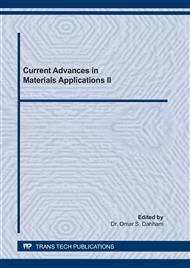[1]
R. Kalaiyarasi, K. Rajathi, Antibacterial Activities and Biofilm Inhibition of CdS Nanoparticles Prepared from Tri Substituted Imidazolium Ionic Liquids, Inter. J. of Sci and Res (IJSR) 5, 9 (2016).
Google Scholar
[2]
S. Guozhen, C. Jung Hee, Y. Jin Kyoung, Y. Gyu-Chul, and L. Cheol Jin, Synthesis of single-crystal CdS microbelts using a modified thermal evaporation method and their photoluminescence, J Phys Chem B. 109,19 (2005) 9294-805.
DOI: 10.1021/jp044888f
Google Scholar
[3]
E.A. Kadash, A.A. AL Hattami, J.R. Rathod, K.D. Patel, V.M. Pathak, Synthesis and Characterization of Cadmium Sulfide Crystals Grown by DVT Technique, Inte. J. of Pure & Appl. Sci. & Technolo. 22 ,1 (2014)18-26.
Google Scholar
[4]
H. Rajbongshi, D. Kalita, Morphology-Dependent Photocatalytic Degradation of Organic Pollutant and Antibacterial Activity with CdS Nanostructures. Journal of Nanoscience and Nanotechnology, 20,9 (2020) 5885-5895.
DOI: 10.1166/jnn.2020.18552
Google Scholar
[5]
Z. Jing, L. Tan, F. Li, Photocatalytic and antibacterial activities of CdS nanoparticles prepared by solvothermal method, Indi. J. of Chemist. Section a 52,1 (2013) 57-62.
Google Scholar
[6]
K. Ashwani, S. Sunity, K. Dinesh, Evaluation of Antimicrobial Potential of Cadmium Sulphide Nanoparticles against Bacterial Pathogens, Int. J. Pharm. Sci. Rev. Res. 24(2) (2014) 202-20.
Google Scholar
[7]
T. Iqbal, A. Faisal, N.R. Khalid, M. Bilal Tahir, I. Mohsin, Facile synthesis and antimicrobial activity of CdS-Ag2S nanocomposites, Bioorganic Chemistry 90 (2019) 103064.
DOI: 10.1016/j.bioorg.2019.103064
Google Scholar
[8]
M. Yoshiteru Mizukoshi, Immobilization of noble metal nanoparticles on the surface of TiO2 by the sonochemical method: photocatalyticproduction of hydrogen from an aqueous solution of ethanol, Ultrason. Sonochem. 14,3 (2007) 387–392.
DOI: 10.1016/j.ultsonch.2006.08.001
Google Scholar
[9]
R. Gannimani, A. Perumal, S. B Krishna K. Muthusamy, A. Mishra, P. Govender, Synthesis and Antibacterial Activity of Silver And Gold Nanoparticles Produced using Aqueous Seed Extract of Protorhus Longifolia as a Reducing Agent, Digest Journal of Nanomaterials and Biostructures, 9,4 (2014) 1669-1679.
Google Scholar
[10]
J. Azhar Bohan, K. Ghaed Salman, S. Duha Ahmed, Enhanced bioactivity of Pure ZnO and ZnO-Ag nanocomposite Using Sol-Gel method for Self-Cleaning Application, Int. J. Res. Pharm. Sci., 10,4 (2019) 3649-3656.
DOI: 10.26452/ijrps.v10i4.1748
Google Scholar
[11]
J. Awiyada Haider, L. Ali Abed, S. Duha Ahmed, Formation Silver Nanoparticles of Different Size Using Different Reductants with AgNO3 Solution, Iraqi J. of Sci. 57:2B (2016) 1203-1209.
Google Scholar
[12]
K. Ziaul Raza, M. Zulfequar Mohd, K. Shahid, Optical and structural properties of thermally evaporated cadmium sulphide thin films on silicon (1 0 0) wafers, Materi. Sci. and Enginee. B 174, 1-3 (2010) 145-149.
DOI: 10.1016/j.mseb.2010.03.006
Google Scholar
[13]
S.A. Vanalakar, S.S. Mali, M.P. Suryavanshi, P.S. Patil, Quantum Size Effect in Chemosynthesized Nanostructured CdS Thin Films, Digest J. of Nanomaterials & Biostructures 5 ,4 (2010): 805-810.
Google Scholar
[14]
H. A-E Omar, A.S. Abdallah, Characterization and antibacterial capabilities of nanocrystalline CdS thin films prepared by chemical bath deposition, Mater. Sci. Semiconduc. Process. 35(2015)132–138.
DOI: 10.1016/j.mssp.2015.03.003
Google Scholar
[15]
P. Samiyammal, K. Parasuraman, A.R. Balu, Improved magnetic and photocatalytic properties of spray deposited (Li+Co) codoped CdS thin films. Superlattices and Microstructures, 129(2019) 28-39.
DOI: 10.1016/j.spmi.2019.03.005
Google Scholar
[16]
H.A.E. Omar, A.S. Abdallah, Characterization and antibacterial capabilities of nanocrystalline CdS thin films prepared by chemical bath deposition, Materi. Sci. in Semicond. Proce., 35 (2015) 132-138.
DOI: 10.1016/j.mssp.2015.03.003
Google Scholar
[17]
S. Alpdoğan, A.O. Adıgüzel, B. Sahan, M. Tunçer and H. Metin Gubur, Effects of bacteria on CdS thin films used in technological devices, Mater. Res. Express 4(2017) 046402.
DOI: 10.1088/2053-1591/aa6919
Google Scholar
[18]
R. Shilpa, H.C. Kumar, S. Ananda, Synthesis of CdS Nanoparticles by Electrochemical Method: Correlation for Photodegradation of Trichloroacetic Acid, Chloroacetic Acid, Acetic Acid and Antibacterial Efficiency. J. Nanosci. Tech. 6,1 (2020) 874-878.
DOI: 10.30799/jnst.294.20060104
Google Scholar
[19]
S. Aishwarya, K R Sanjay. Study on Biological Synthesis of Cadmium Sulfide Nanoparticles by Bacillus licheniformis and Its Antimicrobial, Nanosci. Nanotechnol. Resear, 3,1(2015) 6-15.
Google Scholar
[20]
M. Nafiseh, M.R. Seyeed, C. Isabella, V. Alberto, Deposition of Nanostructured CdS Thin Films by Thermal Evaporation Method: Effect of Substrate Temperature, Materi. 10 (2017) 773.
DOI: 10.3390/ma10070773
Google Scholar
[21]
K. Senthil, D. Mangalaraj, Structural and optical properties of CdS thin films, Appl. Surf. Sci. 169-170(2001) 476–479.
DOI: 10.1016/s0169-4332(00)00732-7
Google Scholar


